Module 2: Senior Leader Engagement
AHRQ Safety Program for Long-Term Care: HAIs/CAUTI
Slide 1: Module 2: Senior Leader Engagement

Slide 2: Objectives

- Identify characteristics of successful senior leaders.
- List five practices of effective leaders.
- Describe the responsibilities of senior leaders.
- Explain the role of the senior leader in addressing technical and adaptive work.
- Describe how to engage the senior leadership in the facility's initiatives and develop shared accountability for the work needed to achieve the facility's safety goals.
Slide 3: What Is Senior Leader Engagement?1

- Listening.
- Learning.
- Partnering with staff.
- Setting team goals.
- Facilitating progress toward goals.
- Removing identified barriers.
Image: It shows two leaders
1. Engage the Senior Executive module, CUSP Toolkit. Rockville, MD: Agency for Healthcare Research and Quality.
Slide 4: Why Is Senior Leader Engagement Important?

- Validates project importance.
- Demonstrates leadership support to staff and to resident safety.
- Increases staff motivation and buy-in for project.
- Provides accountability to project goals.
Image: It shows a group of staff
Slide 5: Senior Leadership Characteristics

- Senior leader clinical or administrative.
- Actively engaged.
- Interest in resident safety.
- Willing to listen, learn, and work with staff to improve patient safety and the quality of health care delivery in the facility.
Image: Group of staff around a table
Slide 6: Models For Leadership2

| What does a leader do? | How does a leader do it? |
|---|---|
| Model the Way | Effective communication |
| Inspire a Shared Vision | Align efforts and priorities Understand and support the work of change |
| Challenge the Process | Listen and learn though regular team meetings |
| Enable Others To Act | Collaborate with others Ensure project accountability |
| Encourage the Heart | Determine project success Reward and recognition |
2. Kouzes JM, Posner BZ. The Leadership Challenge. San Francisco: John Wiley & Sons; 2007.
Slide 7: The Five Practices and Ten Commitments of Leadership2

| Practice | Commitment |
|---|---|
| Model the Way | 1. Find your voice by clarifying your personal values. 2. Set the example by aligning actions with shared values. |
| Inspire a Shared Vision | 3. Envision the future by imagining exciting and enabling activities. 4. Enlist others in a common vision by appealing to shared aspirations. |
| Challenge the Process | 5. Search for opportunities by seeking innovative ways to change, grow and improve. 6. Experiment and take risks by constantly generating small wins and learning from mistakes. |
| Enable Others to Act | 7. Foster collaboration by promoting cooperative goals and building trust. 8. Strengthen others by sharing power and discretion. |
| Encourage the Heart | 9. Recognize contributions by showing appreciation for individual excellence. 10. Celebrate the values and victories by creating a spirit of community. |
2. Kouzes JM, Posner BZ. The Leadership Challenge. San Francisco: John Wiley & Sons; 2007.
Slide 8: Senior Leader Roles and Responsibilities1,3

- Demonstrates improved communication.
- Aligns effort with other strategic priorities.
- Understands and supports the technical and adaptive work of change.
- Meets with the facility team monthly to optimize teamwork.
- Holds all staff accountable for carrying out agreed-upon activities designed to reduce resident harms.
- Collaborates with others to develop and implement a plan that addresses the safety issues the facility staff, residents, and family members identify.
- Supports the process changes through recognition and reward, especially when goals are met.
- Determines with the facility team members when the project has been successful and assist in hardwiring the process.
1. Engage the Senior Executive module, CUSP Toolkit. Rockville, MD: Agency for Healthcare Research and Quality.
3. Bowers N, Nolet K, Roberts, E, et al. Implementing Change in Long-Term Care: A Practical Guide to Transformation. University Wisconsin–Madison, School of Nursing; 2007.
Slide 9: Model the Way

- Clarify values.
- Set the example.
Image: It showing staff looking at a table.
Slide 10: Inspire a Shared Vision4

- Envision the future
- Enlist others in a common vision
- Understand and support the work of change
- Technical
- Adaptive
Image: Staff discussing as a group
Slide 11: A Shared Vision

Image: Indicating a video
PLAY VIDEO:
Video 2.1: Importance of Infection Prevention
Slide 12: Challenge the Process
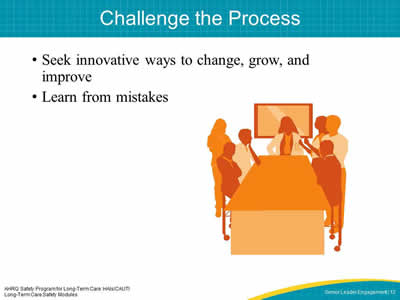
- Seek innovative ways to change, grow, and improve.
- Learn from mistakes.
Image: Staff at a table
Slide 13: Enable the Team

Image: Indicating a video
PLAY VIDEO:
Video 2.2: Enabling the Team
Slide 14: Enable Others To Act
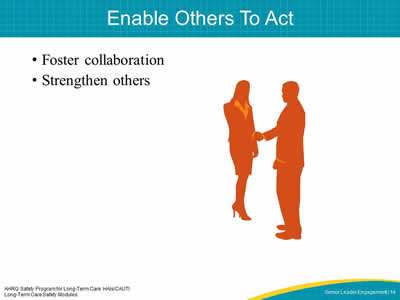
- Foster collaboration.
- Strengthen others.
Image: Two staff shaking hands
Slide 15: A Collaborative Effort

Image: Indicating a video
PLAY VIDEO:
Video 2.3: A Collaborative Effort
Slide 16: Encourage the Heart
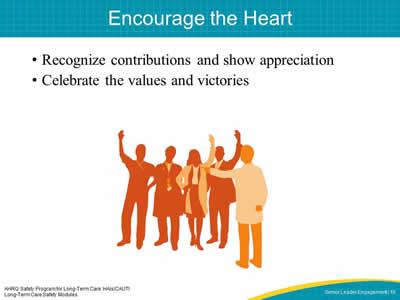
- Recognize contributions and show appreciation.
- Celebrate the values and victories.
Image: Staff raising their hands
Slide 17: An Engaged Team Effort
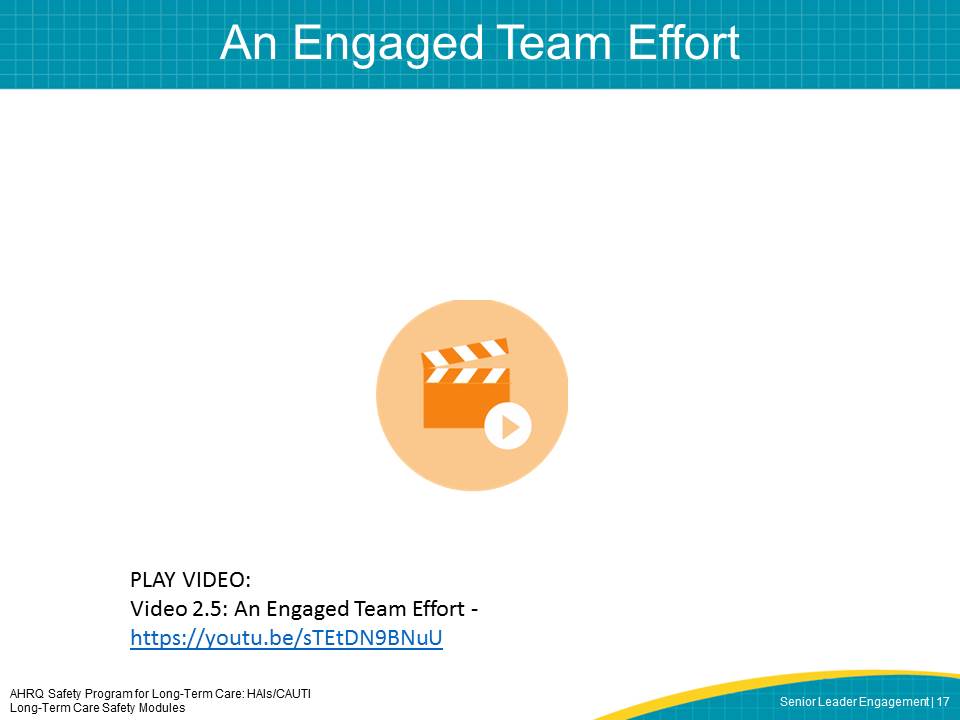
Image: Indicating a video
PLAY VIDEO:
Video 2.5: An Engaged Team Effort
Slide 18: Tools for Senior Leaders
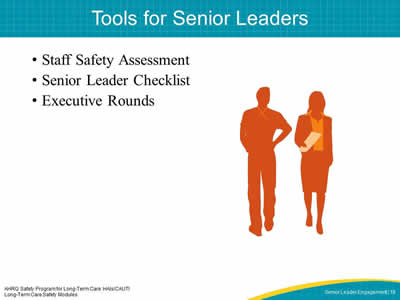
- Staff Safety Assessment.
- Senior Leader Checklist.
- Executive Rounds.
Image: Two staff walking
Slide 19: Staff Safety Assessment Tool
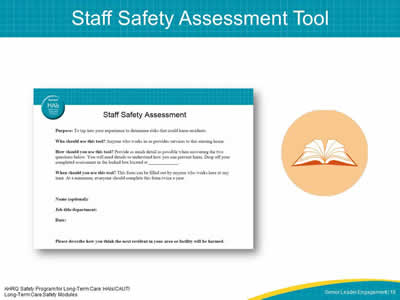
Images: The purpose of the Staff Safety Assessment is to tap into your experience to determine risks that could harm residents.
Indicating that this slide includes a tool
Slide 20: Senior Leader Checklist Tool
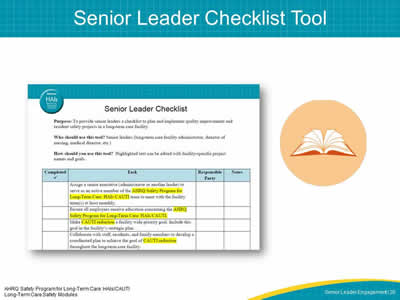
Images: The Senior Leader Checklist purpose is to provide senior leaders a checklist to plan and implement quality improvement and resident safety projects in a long-term care facility.
Indicating that this slide includes a tool
Slide 21: Learn From Defects Tool

Images: The purpose of the Learn from Defects tool is to identify the types of systems that contributed to the defect (an event or situation that you do not want to happen again) and to plan the followup steps needed to improve safety
Indicating that this slide includes a tool
Slide 22: Executive Rounds6
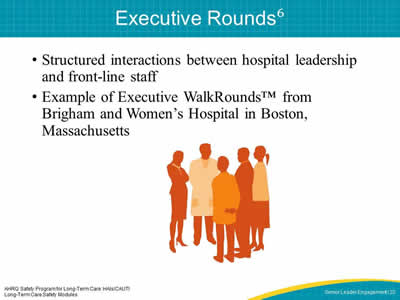
- Structured interactions between hospital leadership and front-line staff.
- Example of Executive WalkRounds™ from Brigham and Women's Hospital in Boston, Massachusetts.
Image: Staff huddled in a group
6. Brigham and Women's Hospital. Other Patient Safety Initiatives - Safety Matters: Executive WalkRounds, Quality of Patient Care. Boston, MA: Brigham and Women's Hospital. Accessed Sept 22, 2014.
Slide 23: How To Engage Your Senior Leader and Develop Shared Accountability
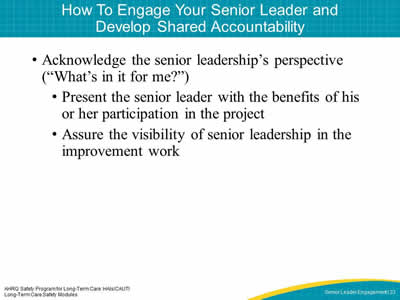
- Acknowledge the senior leadership's perspective ("What's in it for me?")
- Present the senior leader with the benefits of his or her participation in the project.
- Assure the visibility of senior leadership in the improvement work.
Slide 24: Engaging your Senior Leader Using the 4 Es for Technical and Adaptive Work5
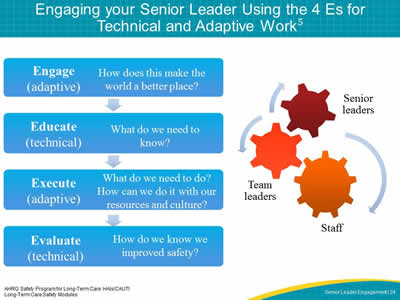
Images: The roles of staff, team leaders and senior leaders are interconnected when unit teams apply the 4 E's. The 4 E's require teams and their leaders to Engage, Educate, Execute and Evaluate their involvement in the CUSP program.
Gears symbolizing the roles of staff, unit team leaders and senior leadership depict the interconnected and dependent relationship that exists between each aspect of the unit team.
5. Pronovost PJ, Berenholtz SM, Goeschel CA, et al. Creating high reliability in health care organizations. Health Services Research. 2006;41(4 pt. 2):1599-1617. PMID: 16898981.
Slide 25: Potential Challenges
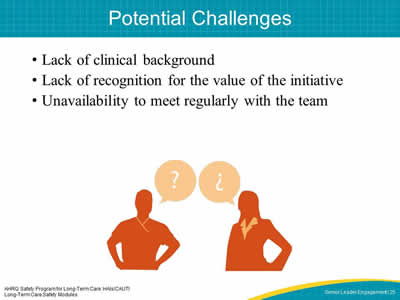
- Lack of clinical background.
- Lack of recognition for the value of the initiative.
- Unavailability to meet regularly with the team.
Image: Two staff having unclear communication
Slide 26: Tools for Engaging Senior Leadership
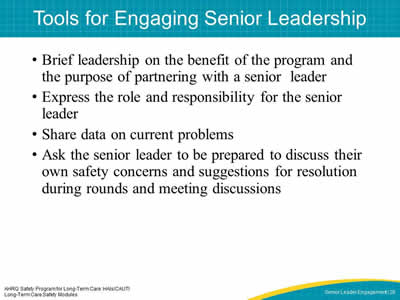
- Brief leadership on the benefit of the program and the purpose of partnering with a senior leader.
- Express the role and responsibility for the senior leader.
- Share data on current problems.
- Ask the senior leader to be prepared to discuss their own safety concerns and suggestions for resolution during rounds and meeting discussions.
Slide 27: Action Plan for Engaging Senior Leader
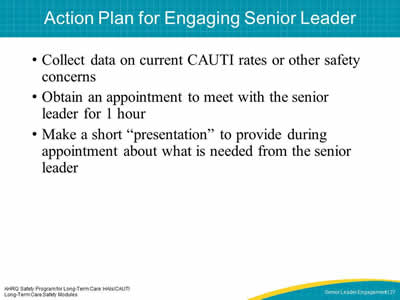
- Collect data on current CAUTI rates or other safety concerns.
- Obtain an appointment to meet with the senior leader for 1 hour.
- Make a short "presentation" to provide during appointment about what is needed from the senior leader.
Slide 28: Exercise
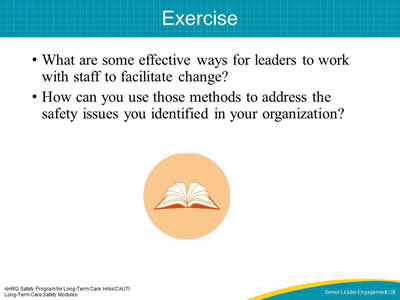
- What are some effective ways for leaders to work with staff to facilitate change?
- How can you use those methods to address the safety issues you identified in your organization?
Slide 29: Key Concepts Review
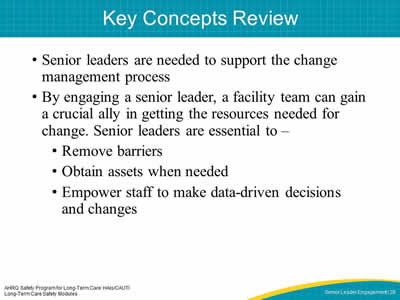
- Senior leaders are needed to support the change management process.
- By engaging a senior leader, a facility team can gain a crucial ally in getting the resources needed for change. Senior leaders are essential to –
- Remove barriers.
- Obtain assets when needed.
- Empower staff to make data-driven decisions and changes.
Slide 30: References
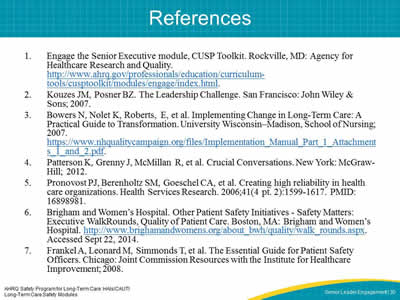
- Engage the Senior Executive module, CUSP Toolkit. Rockville, MD: Agency for Healthcare Research and Quality.
- Kouzes JM, Posner BZ. The Leadership Challenge. San Francisco: John Wiley & Sons; 2007.
- Bowers N, Nolet K, Roberts, E, et al. Implementing Change in Long-Term Care: A Practical Guide to Transformation. University Wisconsin–Madison, School of Nursing; 2007.
- Patterson K, Grenny J, McMillan R, et al. Crucial Conversations. New York: McGraw-Hill; 2012.
- Pronovost PJ, Berenholtz SM, Goeschel CA, et al. Creating high reliability in health care organizations. Health Services Research. 2006;41(4 pt. 2):1599-1617. PMID: 16898981.
- Brigham and Women's Hospital. Other Patient Safety Initiatives - Safety Matters: Executive WalkRounds, Quality of Patient Care. Boston, MA: Brigham and Women's Hospital. Accessed Sept 22, 2014.
- Frankel A, Leonard M, Simmonds T, et al. The Essential Guide for Patient Safety Officers. Chicago: Joint Commission Resources with the Institute for Healthcare Improvement; 2008.



